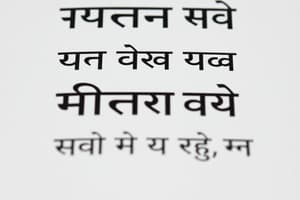Podcast
Questions and Answers
Which language family does Hindi belong to?
Which language family does Hindi belong to?
- Austroasiatic
- Indo-Aryan (correct)
- Sino-Tibetan
- Dravidian
What is the writing system used for Hindi?
What is the writing system used for Hindi?
- Devanagari (correct)
- Arabic
- Cyrillic
- Roman
From which language can the origins of Hindi be traced?
From which language can the origins of Hindi be traced?
- Urdu
- Persian
- Sanskrit (correct)
- Arabic
Which dialect did modern Hindi evolve from?
Which dialect did modern Hindi evolve from?
Which language is Hindi mutually intelligible with?
Which language is Hindi mutually intelligible with?
What is Hindi cinema commonly known as?
What is Hindi cinema commonly known as?
In Hindi grammar, how are nouns classified?
In Hindi grammar, how are nouns classified?
Which direction is Devanagari script written in?
Which direction is Devanagari script written in?
When is Hindi Diwas celebrated?
When is Hindi Diwas celebrated?
Hindi is recognized by the Indian Constitution as the official language of what?
Hindi is recognized by the Indian Constitution as the official language of what?
Which of the following is considered the father of modern Hindi literature?
Which of the following is considered the father of modern Hindi literature?
In what field can proficiency in Hindi be an asset?
In what field can proficiency in Hindi be an asset?
Which of these is an effective way to learn Hindi?
Which of these is an effective way to learn Hindi?
Which of the following Hindi words has been adopted into the English language?
Which of the following Hindi words has been adopted into the English language?
Hindi songs are often featured in which of the following?
Hindi songs are often featured in which of the following?
Learning Hindi can provide a deeper understanding of what aspect of Indian culture?
Learning Hindi can provide a deeper understanding of what aspect of Indian culture?
What is one of the challenges learners face when studying Hindi grammar?
What is one of the challenges learners face when studying Hindi grammar?
Learning Hindi allows one to connect with millions of people and appreciate the richness and diversity of what country?
Learning Hindi allows one to connect with millions of people and appreciate the richness and diversity of what country?
Flashcards
What is Hindi?
What is Hindi?
An Indo-Aryan language, one of India's two official languages, spoken in 9 states and 3 union territories.
What is Devanagari?
What is Devanagari?
The writing system used for Hindi.
What is Khariboli?
What is Khariboli?
The dialect from which modern standard Hindi evolved.
What is Urdu?
What is Urdu?
Signup and view all the flashcards
What is Sanskrit?
What is Sanskrit?
Signup and view all the flashcards
What is Bollywood?
What is Bollywood?
Signup and view all the flashcards
What is Subject-Object-Verb (SOV)?
What is Subject-Object-Verb (SOV)?
Signup and view all the flashcards
What is English?
What is English?
Signup and view all the flashcards
Hindi Diwas
Hindi Diwas
Signup and view all the flashcards
Hindi's Constitutional Status
Hindi's Constitutional Status
Signup and view all the flashcards
Resources for learning Hindi
Resources for learning Hindi
Signup and view all the flashcards
Hindi's Influence on English
Hindi's Influence on English
Signup and view all the flashcards
Father of Modern Hindi Literature
Father of Modern Hindi Literature
Signup and view all the flashcards
Key Figures in Hindi Poetry
Key Figures in Hindi Poetry
Signup and view all the flashcards
Hindi in Religious Rituals
Hindi in Religious Rituals
Signup and view all the flashcards
Challenges in Hindi Grammar
Challenges in Hindi Grammar
Signup and view all the flashcards
Hindi's Evolution
Hindi's Evolution
Signup and view all the flashcards
Value of Learning Hindi
Value of Learning Hindi
Signup and view all the flashcards
Study Notes
- Hindi is an Indo-Aryan language mainly spoken in India.
- It shares status as one of two official languages of India's government.
- Hindi is an official language in 9 states and 3 union territories of India.
- Several dialects exist alongside the standardized version of Hindi.
- The Devanagari script is used to write Hindi.
- Sanskrit provides the historical roots of Hindi.
- Modern Hindi's evolution comes from the Khariboli dialect.
- Khariboli rose to prominence around the 18th century.
- The 20th century saw the standardization of Hindi.
- Hindi and Urdu are mutually intelligible languages.
- Associations link Urdu to Muslims and Pakistan, while Hindi is linked to Hindus and India.
- Both Hindi and Urdu share a foundational grammatical structure.
- Sanskrit is the source of much of Hindi's vocabulary.
- Urdu's vocabulary is influenced more by Persian and Arabic.
- Hindi ranks as the fourth most spoken language worldwide.
- India is home to the majority of Hindi speakers.
- Sizeable Hindi-speaking populations are present in other countries.
- Nepal, Fiji, Mauritius, and South Africa have Hindi-speaking communities.
- A long history characterizes Hindi literature.
- Religious texts, philosophical works, modern novels, and poetry comprise it.
- Hindi cinema, known as Bollywood, is a significant cultural force.
- Bollywood ranks among the world's largest film industries.
- Indian society relies on Hindi in important ways.
- Politics, education, and entertainment are all impacted.
- Understanding Indian culture can be enhanced by learning Hindi.
- Communication within India can be improved by knowing Hindi.
- The grammar of Hindi relies on nouns, pronouns, verbs, and adverbs.
- Grammatical gender is present in Hindi nouns (masculine and feminine).
- Hindi verbs are conjugated based on tense, aspect, and mood.
- The typical structure of Hindi sentences is subject-object-verb.
- Hindi employs postpositions instead of prepositions.
- The noun or pronoun that postpositions govern follows it.
- The Devanagari script is written from left to right.
- Consisting of 11 vowels and 33 consonants, Each character represents a sound.
- The pronunciation of Hindi is generally phonetic.
- Pronunciation closely matches written words.
- Modern Hindi commonly uses loanwords from English.
- Hindi pronunciation often adapts these loanwords.
- The Central Hindi Directorate works to promote Hindi.
- Its use and development are regulated by the organization.
- September 14th is celebrated as Hindi Diwas.
- The holiday marks Hindi's acceptance as an official language of India.
- Job opportunities can arise from knowing Hindi.
- Translation, interpretation, and teaching positions may become available.
- Hindi proficiency can be valuable in various fields.
- These fields include tourism, media, and international business.
- The Indian Constitution recognizes Hindi as the official language.
- It should serve as a medium of expression for all elements of India.
- Government initiatives promote Hindi through educational programs and cultural exchanges.
- Many resources are available for learning Hindi.
- Textbooks, online courses, and language learning apps are available.
- Immersion is an effective way to learn Hindi.
- Spending time in a Hindi-speaking environment aids learning.
- Hindi has influenced other languages.
- English has adopted some Hindi words.
- "Guru," "karma," and "yoga" are examples of borrowed words.
- The use of Hindi is growing on the internet and social media.
- The growth reflects the increasing digital presence of Hindi speakers worldwide.
- Hindi literature includes works of poetry, drama, fiction, and non-fiction.
- Bhartendu Harishchandra is considered the father of modern Hindi literature.
- Munshi Premchand was a prominent Hindi novelist and short story writer.
- Hindi poetry has a rich tradition.
- Prominent figures include Kabir, Tulsidas, and Surdas.
- Hindi cinema has a global audience.
- Hindi films are popular in many countries outside of India.
- Hindi songs are an integral part of Indian culture.
- Hindi songs are often featured in Bollywood movies.
- Newspapers, television, and radio all use Hindi.
- Learning Hindi can provide a deeper understanding of Indian philosophy by exploring religious texts and spiritual teachings.
- Many religious ceremonies and rituals use Hindi.
- These ceremonies and rituals are common in Hinduism and other Indian religions
- The grammar of Hindi can be challenging for learners because gendered nouns and verb conjugations are tricky.
- Anyone can learn to speak Hindi with dedication and practice.
- Consistent effort is required to learn Hindi.
- Many find learning Hindi rewarding and enjoy learning the language and culture.
- Hindi continues to evolve.
- It adapts to modern times and embraces new technologies and forms of expression.
- Hindi is a vibrant and dynamic language.
- It is deeply connected to the culture and heritage of India.
- The promotion of Hindi is a topic of debate in India.
- Some advocate for its wider use, while others emphasize the importance of multilingualism.
- The future of Hindi looks promising.
- There is growing interest in the language both in India and abroad.
- Learning Hindi opens doors to a world of culture, history, and opportunity.
- It allows one to connect with millions of people and appreciate the richness and diversity of India.
- Traveling to India can immerse oneself in the language and culture, enhancing the learning experience.
- Many opportunities exist to practice Hindi in India, such as speaking with locals and attending cultural events.
- Hindi serves as a bridge between different cultures.
- It connects people from various backgrounds and promotes understanding and communication.
Studying That Suits You
Use AI to generate personalized quizzes and flashcards to suit your learning preferences.




